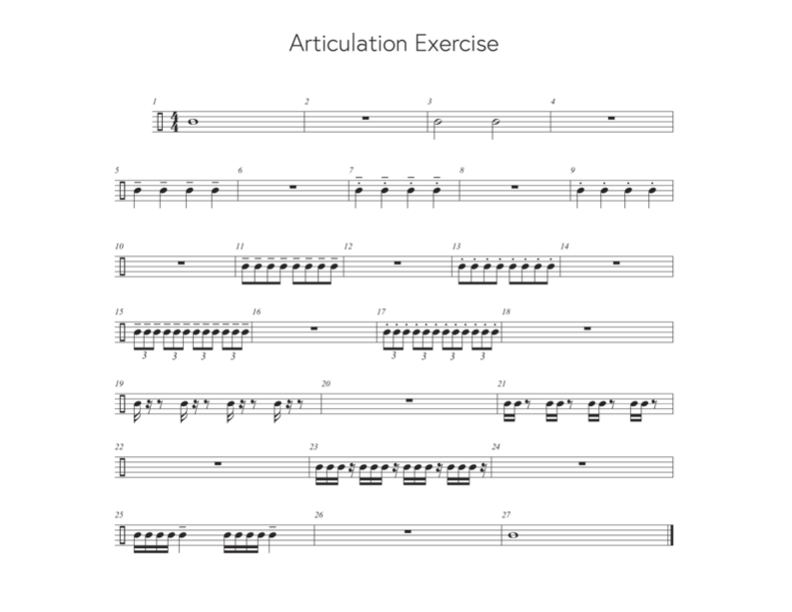
My favorite thing in the world to teach is fundamentals. The development and continued refinement of fundamental skills are key to the overall success of our students and ensembles. What we choose as the fundamental skills our students need to develop should be a reflection of the priorities we’ve set for our program.
I firmly believe that focusing on the fundamental skills (specifically tone production, articulation, rhythm, technique, and style as appropriate) lead to both individual development and ensemble development since each of these skills build on the one before it.
Once students are able to produce a great sound, the next most important aspect of their playing is articulation. I believe that articulation should be worked on every day. One of the best parts of working on articulation is that kids can hear the improvement. It’s an immediate change. They want instant gratification—everything to happen right away—and articulation is one of those things that you can hook them on and give them the feeling of “Oh, this is cool. I do sound better.” Even in the first year of playing, I encourage everyone to work on the development of fundamental articulation, and to do an articulation exercise. It can be very short at the start and develop over time as the students continue to progress.
Check out these recommended articulation exercises from Alfred Music’s Sound Innovations: Ensemble Development for Intermediate Concert Band series.
Just like when you speak, articulation is important for clarity of what is being said or played. Ensuring that all students articulate correctly requires individual attention. Since you cannot see what they are doing inside their mouth, you must be persistent when you teach. Never be afraid to teach and reteach again!
Sample Articulation Exercise, courtesy of Robert Herrings: click here to download
As the teacher, having an understanding of where the tongue should touch inside of the mouth or on the reed is part of what we need to define for our students. Even within brass playing, where the tongue touches will vary from instrument to instrument. I am a firm believer in only giving the students the information they need. We don’t want to complicate things for them. Be short, clear, and concise. If we start trying to dissect it and get really “scientific” about what’s happening inside the mouth, then things will start to get distorted.
Articulation also changes with each student depending on their teeth structure. These days they will come to school with all sorts of orthodontic contraptions in their mouths! We are sometimes stuck trying to figure out different ways to get students to articulate clearly so they don’t distort their tone in spite of those devices.
One tool which is really helpful when teaching articulation is to have students start notes without their tongue: an air attack. An air attack is when you have the student make a fundamental sound with no distortion to the tone. Once that tone has been achieved, add the tongue back in at the start of the note. The goal is to have no change in the air speed or the embouchure from the successful air attack. Adding the tongue back in should only offer more clarity to the start of their sound. A phrase I often use and learned from a really smart band director is, “airspeed drives articulation.” We all know that if we want students to play with a great sound, they need to use great air. If the air is fast behind the tongue and the kids are able to execute very clear articulation, the tone qualities take care of themselves. A lot of times, some of the intonation takes care of itself, too!
As the students develop in their playing, define note starts and releases. So many bands do not start or end together! This is a skill that has to be taught and reinforced through repetition. Listen critically and address concerns as they arise. A beautiful note-start hinges on the intake of the breath and the tongue moving down quickly and together at the start of the note. The phrase “A band that breathes together, plays together,” stands true. With note releases, I stress that students should stop the note by breathing in, holding the vowel sound on the note-end and staying relaxed. The follow through of the note-end is often overlooked. No matter the duration, notes should all start and end together. With younger players, this is a skill that has to be monitored and reinforced consistently. To fully develop the students’ awareness and skill, vary articulation patterns to challenge their growth.
Ensemble articulation consists of the combination of each individual performer’s articulation (consistency) and the overall transparency of the ensemble. This can be developed by modeling, the use of consistent language, working an articulation exercise, varying articulation patterns, the use of subdivision exercises, and vocalizations
Keeping these keys to successful articulation in mind—quality, strength, speed of tongue, and support of air—will make an immediate impact in the sound of your ensemble.
